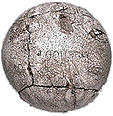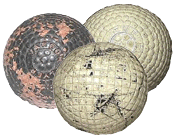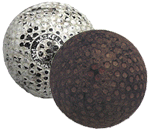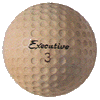A History of the Golf Ball
In the earliest days of golf on the eastern coast of Scotland, players used primitive equipment to play the game in a rather haphazard and casual manner. The first clubs and balls specifically made for golf were fashioned from wood. One documented reference is that of a John Daly playing with a wooden ball in 1550.
In 1618 the feather golf ball or 'Featherie' was introduced. This was a handcrafted ball made with goose feathers tightly packed into a horse or cow hide sphere. The feathers and leather were fashioned into a ball while wet. As the assembly dried out the leather shrank and the feathers expanded to create a hardened ball. The ball was then finished off by painting it and punched with the ball-makers mark. Quality varied according to the skill of the craftsman. Unfortunately, the handcrafted nature of the balls meant that they were priced beyond the pockets of the masses, sometimes more expensive than a club. Notable ball-makers of the 1600s were Andrew Dickson, Leith and Henry Mills, St Andrews.
or cow hide sphere. The feathers and leather were fashioned into a ball while wet. As the assembly dried out the leather shrank and the feathers expanded to create a hardened ball. The ball was then finished off by painting it and punched with the ball-makers mark. Quality varied according to the skill of the craftsman. Unfortunately, the handcrafted nature of the balls meant that they were priced beyond the pockets of the masses, sometimes more expensive than a club. Notable ball-makers of the 1600s were Andrew Dickson, Leith and Henry Mills, St Andrews.
The introduction of the Gutta Percha ball or 'Guttie' in 1848 by Rev Adam Paterson of St. Andrews and the spread of the railways directly contributed to the expansion of golf. The Guttie ball was made from the rubber like sap of the Gutta tree found in the tropics. When heated the rubber could easily be fashioned into a sphere and used as a golf ball. Not only could the ball be relatively cheaply produced, it could also be easily repaired by re-heating and then re-shaping. Initially Gutties had a smooth surface which meant that they didn't travel as far as the Featheries. The balls were usually stamped with the ball makers stamp, most notably Allan Robertson.
repaired by re-heating and then re-shaping. Initially Gutties had a smooth surface which meant that they didn't travel as far as the Featheries. The balls were usually stamped with the ball makers stamp, most notably Allan Robertson.
After 1880, gutties were produced with patterns on their surface in an attempt to reproduce the distance characteristics of a scored Featherie. With the Victorians came industrialisation and mechanisation, and by 1890 Gutties were being made in moulds which further increased their affordability, consistency and quality. The most notable pattern of the period was the 'Bramble' - raised spherical bumps across the surface of the ball. Many of the rubber companies including Dunlop began mass-producing balls which killed off the handcrafted ball business.
In 1898, Coburn Haskell introduced the one-piece rubber cored ball which was universally adopted by 1901 after it proved so effective in the British and US Opens. These balls looked just like Gutties but gave the average golfer an extra 20 yards from the tee. These balls were constructed from a solid rubber core wrapped in rubber thread encased in a gutta percha sphere. Once W. Millison developed a thread winding machine, Haskell balls were mass-produced and therefore more affordable.
These balls were constructed from a solid rubber core wrapped in rubber thread encased in a gutta percha sphere. Once W. Millison developed a thread winding machine, Haskell balls were mass-produced and therefore more affordable.
Throughout this period there was a lot of experimentation with the patterns on golf balls - one of the reasons why golf collecting is so interesting. When William Taylor first applied the dimple pattern to a Haskell ball in 1905, golf balls took on their modern form. The dimple pattern maximises lift while minimising drag.
Manufacturers continued to experiment with golf ball design including Goodrich who introduced the pneumatic ball in 1906 (the patent was held by T. Saunders and filed in 1901). Quite simply this was a Haskell ball with a compressed air core which unfortunately was prone to expansion with heat and therefore causing the ball to explode. Others tried mercury, cork and metal cores.  Only in 1972, when Spalding introduced the first two piece ball, the Executive, was the basic Haskell design improved upon.
Only in 1972, when Spalding introduced the first two piece ball, the Executive, was the basic Haskell design improved upon.
In 1921, the R&A and USGA standardised the size and weight of the ball. Since then further constraints have been proposed which are detailed in the rules. Between 1931 and 1990, both organisations differed on the dimensions of the golf ball which meant that the game played on either side of the Atlantic was similar but different.
Today there is a rich variety of golf balls to suit the individual game and circumstance. Some offer control, some offer distance while others are suitable for practice only. Antique golf balls are avidly collected and are becoming increasingly valuable. A dimple patterned Guttie in good condition is worth about $US 500.

